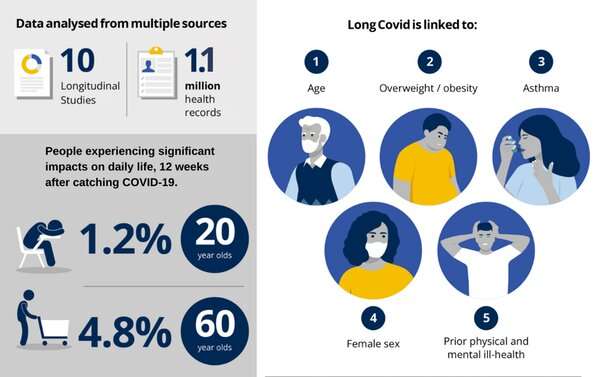
About 2 million people in the U.K. currently have long COVID, according to the latest data from the Office for National Statistics.
In the U.K., long COVID is defined as “signs and symptoms that continue or develop after acute COVID-19.” This definition is further split into people who have symptoms between four to 12 weeks after infection (ongoing symptomatic COVID-19) and for 12 weeks or more (post-COVID syndrome).
Symptoms can include fatigue, breathlessness, difficulty concentrating and many more—but the precise nature of the symptoms is not well understood. There are also gaps in our knowledge when it comes to the frequency of long COVID, and whether there are particular factors that put people at higher risk of developing the condition.
All of this is partly because the symptoms used to define long COVID often vary between studies, and these studies tend to be based on relatively few people. So the results may not apply to the wider population.
In a new study published in the journal Nature Communications, my colleagues and I looked at data from ten U.K.-based long-term studies, alongside 1.1 million anonymized electronic health records from English general practices. Based on this data, we investigated whether the burden of long COVID (how common it is) differs by demographic and health characteristics, such as age, sex and existing medical conditions.
The studies were established before the pandemic, and have tracked participants over many years. From these surveys, we used data from 6,907 people who self-reported they’d had COVID-19. Comparing this with the data from the electronic health records of people diagnosed with COVID allowed us to examine the frequency of long COVID in those who have seen their GP about it and those who haven’t.

We found that of the people who self-reported having COVID in the studies, the proportion who reported symptoms for longer than 12 weeks ranged between 7.8% and 17%, while 1.2% to 4.8% reported “debilitating” symptoms.
In the electronic health records, we found that only 0.4% of people with a COVID diagnosis were subsequently recorded as having long COVID. This low proportion of diagnoses by GPs may be partly because formal logging of long COVID was only introduced for doctors in November 2020.
The proportion of people who reported symptoms for more than 12 weeks varied by age. There was also a lot of variation depending on which definition each study used to capture long COVID. But overall, we found evidence to suggest an increased risk of long COVID was associated with increasing age up to age 70.
The studies include participants across a range of ages, from an average age of 20 to 63. Using a strict definition of symptoms affecting day-to-day function, we found that the proportion of people with symptoms for 12 or more weeks generally rose with increasing age, ranging from 1.2% for 20-year-olds to 4.8% for those aged 63.
We also found that a range of other factors is associated with a heightened risk of developing long COVID. For instance, being female, poorer pre-pandemic mental health and overall health, obesity and having asthma were also identified as risk factors in both the long-term studies and electronic health records.
These findings are broadly consistent with other emerging evidence on long COVID. For example, a recent international review study concluded that women are 22% more likely than men to experience long COVID.
Source: Read Full Article





